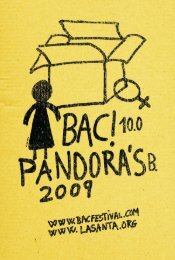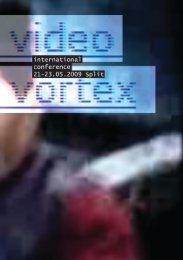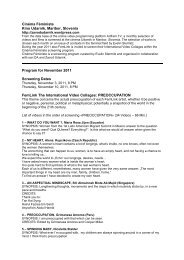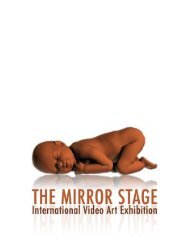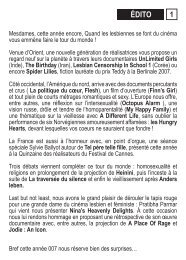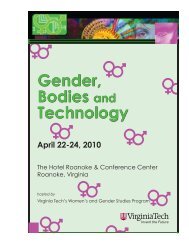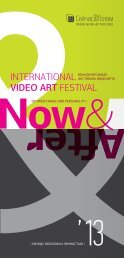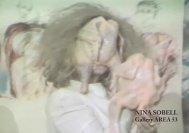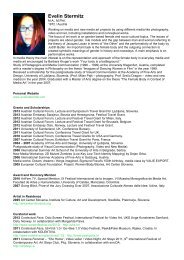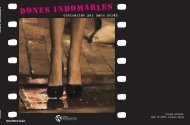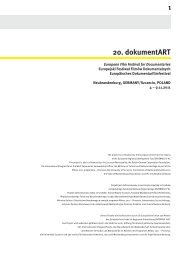PoznaÅ
PoznaÅ
PoznaÅ
You also want an ePaper? Increase the reach of your titles
YUMPU automatically turns print PDFs into web optimized ePapers that Google loves.
6/<br />
ERASED WALLS OR INVISIBLE WALLS<br />
ERASED WALLS CZY INVISIBLE WALLS<br />
The tittles of successive exhibitions Der Riss im Raum (Berlin 1994),<br />
Aer the Wall (Stockholm 1999) and Erased Walls (part of the<br />
Mediations Biennale in Poznan, Crazycurators Biennale in Bratislava<br />
and in the Freies Museum and ConcentArt e.V. in Berlin) create<br />
a fascinating narration around issues and the history of Central Europe<br />
seen through art, the mirror of the ages. The 1994 exhibition<br />
initiated the coming together of the Central European countries<br />
– Czech Republic, Slovakia, Poland and Germany. Drawing back<br />
to post-war art, it took a peek behind the Iron Curtain and revealed<br />
the art practice which till then had been censored and shown in the<br />
official light of communist dictatorship. Aer the Wall – 10 years<br />
aer the peaceful revolution, was a presentation of art within a free<br />
Central Europe. Erased Walls focuses on artworks aer the year<br />
2000, emphasizing on the young art of our region, although without<br />
any geopolitical limitations, because the issue of erasing boundaries<br />
concerns the whole world. New walls are appearing and the seemingly<br />
erased are quickly replaced by invisible ones, which are even more<br />
effective and troublesome because unperceived. Local walls are the<br />
extension of global walls. Political divisions are oen replaced by new<br />
limitations associated with the power of capital, social violence,<br />
media manipulation, feelings of solitude and exclusion and many<br />
others. Artists, through the study of the image, arrive to reflections,<br />
which can not be attained neither by word or document.<br />
Tytuły kolejnych wystaw Der Riss im Raum (Berlin 1994), Aer the Wall<br />
(Sztokhlom 1999) i Erased Walls (w ramach Mediations Biennale w Poznaniu,<br />
Crazycurators Biennale w Bratysławie i we Freies Museum i ConcentArt<br />
e.V. w Berlinie) tworzą fascynującą narrację wokół problematyki<br />
i historii Europy Środkowej widzianej poprzez sztukę, lustro dziejów.<br />
Wystawa w 1994 roku inicjowała zbliżenie się krajów Europy Środkowej<br />
– Czech, Słowacji, Polski i Niemiec. Sięgając wstecz do sztuki po 1945 roku,<br />
zaglądała za żelazną kurtynę i odsłaniała życie artystyczne, dotychczas<br />
cenzurowane i pokazywane w oficjalnym świetle dyktatury komunistycznej.<br />
Aer the Wall w 10 lat po pokojowej rewolucji było prezentacja sztuki<br />
w wolnej Europie Środkowej. Erased Walls koncentruje się na twórczości<br />
po 2000 roku, kładąc nacisk na sztukę najmłodszą głównie naszego<br />
regionu, lecz bez ograniczeń geopolitycznych, gdyż problem wymazywania<br />
granic dotyczy całego świata. Pojawiają się nowe mury, a te pozornie<br />
wymazane mury zastępują szybko mury niewidoczne, tym bardziej skuteczne,<br />
dokuczliwe, bo niedostrzegalne. Mury lokalne są przedłużeniem<br />
murów globalnych. Podziały polityczne często zastępują nowe ograniczenia<br />
związane z władzą kapitału, przemocą społeczną, manipulacją mediów,<br />
poczuciem osamotnienia i wykluczenia i wiele innych. Artyści poprzez<br />
studium obrazu dochodzą do refleksji, niedających się skonstruować<br />
ani za pomocą słowa, ani dokumentu. Obraz jest często wyostrzonym<br />
cytatem z rzeczywistości, który w kontekście wystawy i w dialogu z innymi<br />
pracami artystów, staje się niespodziewanie wyrazisty.



